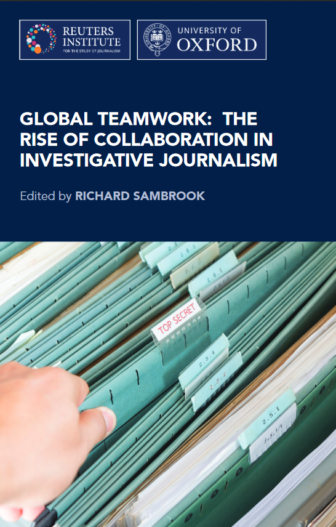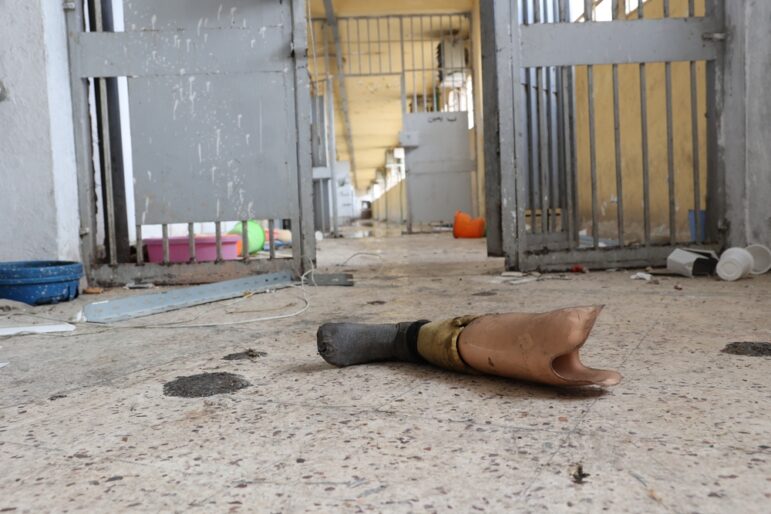

How Journalists, NGOs Can — & Should — Collaborate
Editor’s Note: This is an edited extract of Chapter 5 from the book Global Teamwork: The Rise of Collaboration in Investigative Journalism, written by GIJN’s Program Director Anne Koch. The book, edited by Richard Sambrook, was published by the Reuters Institute for the Study of Journalism. For the full version, including references, click here.
 Corruption is the target of both investigative journalists and anti-corruption NGOs like Transparency International, Global Witness and others. While at Transparency International (TI), I launched a collaborative initiative with the investigative journalism network, the Organized Crime and Corruption Reporting Project (OCCRP). TI has about 100 national affiliates, or chapters, around the globe working to combat corruption. OCCRP, for its part, is an investigative reporting platform formed by more than 40 non-profit investigative centers, scores of journalists and several major regional news organizations across the world, who do transnational investigative reporting and promote technology-based approaches to exposing organized crime and corruption worldwide.
Corruption is the target of both investigative journalists and anti-corruption NGOs like Transparency International, Global Witness and others. While at Transparency International (TI), I launched a collaborative initiative with the investigative journalism network, the Organized Crime and Corruption Reporting Project (OCCRP). TI has about 100 national affiliates, or chapters, around the globe working to combat corruption. OCCRP, for its part, is an investigative reporting platform formed by more than 40 non-profit investigative centers, scores of journalists and several major regional news organizations across the world, who do transnational investigative reporting and promote technology-based approaches to exposing organized crime and corruption worldwide.
Investigative journalists are naming the corrupt, but too often there is little follow up and the corrupt often get away with it. The new OCCRP-TI project is structured so that OCCRP will investigate and expose, and TI will take up a number of stories or cases and undertake advocacy and campaigning work around each case to press for longer-term change. Nevertheless, the partnership raises thorny issues about co-operation between investigative journalists and NGOs.
Some years ago as a senior manager at the BBC, I co-led a global investigation into the cross-border trade in asbestos with the International Consortium of Investigative Journalists (ICIJ), Dangers in the Dust: Inside the Global Asbestos Trade. White asbestos, which the industry prefers to label as chrysotile, is a cancer-causing fiber which kills about 100,000 workers a year according to the International Labour Organization. While asbestos is banned or restricted in much of the world, it is aggressively marketed in developing countries.
Our joint investigation revealed the tactics used by the makers of asbestos building materials to market their products to poorer countries. The multiple cases and stories produced by the partnership made a substantial impact: the findings were not only covered by about 250 media outlets in more than 20 languages they were also used by public health activists and concerned politicians in countries such as Brazil, India, Mexico and Canada.
ICIJ has compiled evidence of the impact the collaboration made; they do this routinely. Later, reviewing the impact, I thought that we could have been even more systematic in the way we collaborated and shared information during and after our work was published. And as a journalist, this was by no means the first time I had pause for thought about how we might increase our impact by working with campaigning organizations.
The relationship between investigative journalists and NGOs, whether working on corruption or other issues, has always been complex and nuanced because their roles often overlap. For as long as I can remember this has been debated and worried over, with claims that the relationship needed redefinition. There is a long history of both collaboration and antagonism between the two, but due to wider changes briefly touched upon below, there has been a massive blurring of the lines. The relationship between the two, it is argued here, should be discussed more widely, made more transparent, and with careful calibration there is greater room for co-operation – without a concomitant loss of independence or integrity.
Although the relationship between journalists and NGOs is not new, the effects of digital disruption, with the explosion of choice, the empowerment as many would see it of audiences, as well as their influence on the agenda and the low levels of trust for journalists, have muddied the waters. In the context, too, of the dominance of the tech giants, the decline in revenue and disappearance of once reliable business models in a mere decade, not to mention the general decline in traditional journalism, the line between professionally trained journalists and alternative investigation and newsgathering has blurred. The economics fueling this trend has been well documented; some of the money has gone online, sometimes to fake news.
Much investigative journalism is now being carried out by relatively small organizations, themselves: NGOs that raise funds from foundations, private donors, companies and governments, a trend that started in the mid-1970s but has accelerated with the collapse of orthodox business models.
In addition, one recent wide-ranging study has documented the growth of what its authors call, “stakeholder driven media”, a “stunning range of actors who control their own media and use those media to directly affect individuals, communities, organizations and society.” This is at the expense of the mainstream media who have lost their share of previous agenda-setting influence at the expense of the stakeholder driven media. This has been accompanied, unsurprisingly, by a sometimes hostile debate about what journalism is and who is qualified to do it, and the increasing and unprecedented threats to journalists the world over where the challenges are huge and varied and include intimidation, violence, media concentration and political control.
Journalists in parts of the media, particularly in North America and Europe, have long relied on a shield of impartiality or objectivity and adhere to strict editorial guidelines when dealing with campaigners, charities and other NGOs. Impartiality as defined by the BBC, as its head of news has argued, “is not the same as objectivity or balance or neutrality … [a]t its simplest it means not taking sides … about providing a breadth of view.” This is at odds with the mission of NGOs. But the concepts of impartiality and objectivity are increasingly questioned and proponents for a so-called post-impartial world are growing, as are the number of journalists who speak openly and often critically about the constraints of impartiality.
In many, if not most parts of the world, the liberal Western model of the necessary separation between journalism and activism is not understood, let alone recognized – one literally can be a journalist in the morning, an activist in the afternoon and a blogger in the evening. I discussed this with young journalists and activists in Moscow, to cite one example, and they didn’t understand my concern with the blurring of lines. The work of NGOs in the area of journalism and investigative journalism is important, too, where there is a lot of media concentration or where media freedom is weak or non-existent. In those environments a lot of the work on investigating and publicizing corruption is done by NGOs.
 It is in this context that TI and OCCRP struck up a novel partnership. The initiative was launched as the Global Anti-Corruption Consortium. As well as investigating stories, OCCRP will build a global networked platform, while TI will advocate and campaign for longer-term change. This might involve a national or global campaign; it might mean taking steps to try and ensure that the corrupt are prosecuted; in others it will be to try and address the systemic causes that lead to corruption – a corrupt judiciary, lax enforcement of money laundering laws and others. TI hopes, too, where possible, to be able to seek redress for victims of cases of grand corruption.
It is in this context that TI and OCCRP struck up a novel partnership. The initiative was launched as the Global Anti-Corruption Consortium. As well as investigating stories, OCCRP will build a global networked platform, while TI will advocate and campaign for longer-term change. This might involve a national or global campaign; it might mean taking steps to try and ensure that the corrupt are prosecuted; in others it will be to try and address the systemic causes that lead to corruption – a corrupt judiciary, lax enforcement of money laundering laws and others. TI hopes, too, where possible, to be able to seek redress for victims of cases of grand corruption.
Both organizations also hope in time it will extend to other NGOs and investigative journalists because greater cooperation with other like-minded and independent NGOs is also needed. As Drew Sullivan, founder, editor and director of OCCRP and TI partner, said to me, “You have reporters investigate a problem. Then activists. Then police. In the three different investigations information is lost and knowledge is not passed through. It’s inefficient. We need to share our information better.”
There is no doubt that the cooperation raises big issues – ethical issues, security issues, a clash of interests and so on. However, in this project both TI and OCCRP are clear that co-operation will be enhanced further by mutual freedom and the maintenance of each party’s independence, structured and flexible cooperation (not coordination per se) and trust.
We will cooperate on the basis of clear evidence and data, with an understanding that each party has a different job to do. Cooperation will be limited and each organization has its own staff, legal support and objectives, and we have clear protocols about sharing information.
If there is a joint commitment to independence, truth and transparency with each other and with audiences/constituencies about conflicts, as well as how successes are achieved, we hope the project will lead to greater impact. It should be noted that we are experimenting and our collaboration may not be entirely new – we just want to make it more systematic.
This partnership is coalescing at a moment when many North American and Western European journalists increasingly have to contend with new colleagues who are don’t fit their assumptions of what a journalist is. Many people who neither have professional qualifications nor work in organizations with an editorial structure are out there writing and shaping public opinion – the two most read blogs during the last UK election, for instance, were from non-journalists.
Moreover, trained journalists and researchers are being hired by campaigning, non-governmental organizations to publish investigative stories. Entities trying out new models include, ProPublica, the Kaiser Foundation and Open Secrets in the US as well as some of the national chapters affiliated with TI in Russia, Honduras, Montenegro and the Czech Republic – to cite a handful. Global Witness, for example, employs journalists and has both initiated and investigated major stories that have been picked up by major media outlets like the Financial Times, The Guardian and ABC News.
Drew Sullivan from OCCRP believes that we are experiencing “a Gutenberg moment” – and we must catch up with changing times. What we have traditionally called journalism is disappearing because of the above-mentioned blurring of roles between activists, bloggers, citizen journalists, watchdogs and journalists.
“If you can’t tell them apart, they are doing the same thing,” states Sullivan. “They are all investigators. Journalists don’t need to be activists – we just need to agree on the findings.” He believes we need to define new roles and confront persistent corruption with “truth, activism and good policy, an enterprise that is at the heart of democracy, by building networks of like-minded investigators.” And this is why OCCRP is building a collaborative platform where journalists and NGOs can share information. “Journalism ethics are important but so is the power and money of crime and corruption in the developing world. We’re losing the battle. Badly.”
But why would an NGO like TI want to cooperate with investigative journalists? The first reason is to share essential evidence and facts – it really is as basic as that. Investigators (both journalists and law enforcement professionals) simply have more experience and know-how in investigating cases, and often journalists have been more open to sharing information than law enforcement agencies, although of course the latter play a role in the wider picture. Good investigative journalists provide documents and evidence, the material that NGOs need to do their advocating and campaigning. The Panama Papers case is an obvious recent example, as are the so-called Lux Leaks documents.
These cases gave rise to extensive work by some NGOs on whistleblowing policy and the role of accountancy firms as enablers of corruption and tax avoidance – numerous others could be cited.
A second vital reason is impact. Journalists often are better able to package and disseminate the findings, and to reach bigger audiences. When Global Witness carried out an undercover investigation of lawyers in New York City and shared their findings with CBS’s 60 Minutes program, this assured an audience of millions. In other cases, it’s about targeting a particular constituency of readers or viewers. Journalism also helps to shape public opinion against sleaze in government, scrutinizes laws and regulations and can prompt governments to respond. One of the most challenging areas in combating corruption is to figure out what has an impact – in short, what works.
A key piece of evidence comes from TI itself. It conducted an extensive survey of business management in 30 countries on the best ways to fight corruption, gathering responses from 3,000 business people across 13 sectors that included real estate, banking, mining, and so on. The survey asked them to rank the effectiveness of six measures, from corporate due diligence to national anti-bribery laws to international treaties. Investigative journalism came out on top: business people in 20 of the 30 countries surveyed chose investigative journalism as the most effective tool at fighting corruption.
GIJN has shown the impact it can make around the world.
OCCRP has its own impressive metrics in showing the impact on corruption of its journalism: more than $ 5.7 billion in assets frozen or seized by governments, more than 1,400 company closures, indictments and court decisions; 84 criminal investigations and government inquiries launched as a result of its stories; and the list goes on. This was one of the many factors that led to the current collaboration with OCCRP.
Despite TI’s research, the reality is that while an expose can bring attention to an issue, raise the stakes and even be a catalyst for change, it is following it up with persistent advocacy, public mobilization and other factors that most often lead to institutional change. However, the impact of journalism can easily be blunted by many other forces. The role that investigative journalism plays is part of a wider picture which TI has compared to a complex machine with many interrelated parts: if one part isn’t functioning, it can throw the whole machine out of kilter or stop it working altogether.
It is this relationship between what investigation can provide and the need to extend it to other organizations that led to the collaboration with TI. In fact, going back to my work at the BBC with the ICIJ on asbestos, the purpose of collaboration is the amplification of impact, whether between journalists or between journalists and campaigners. In a globalized world where reliable information is increasingly challenged, we could do more to raise our game and make greater impact. NGOs already provide a lot of research and expertise, analytical depth and case studies. They pick up cases when the journalists are finished, in effect creating a long tail to the story by advocating for change. This is at the heart of how they can improve impact.
Despite the blurring of lines that I have discussed, I remain convinced that there is a fundamental difference between journalists and NGO activists. Journalists shouldn’t be campaigners and vice versa. They don’t need to be. But to be effective, neither side can be complacent, or draw lines that limit real cooperation. In order to protect and enhance the important work of investigations done by civil society – whether it is by journalists, NGOs or academics who are under attack in many parts of the world, including in the US, and challenged by unprecedented levels and penetration of propaganda and false news – we need to experiment with new forms of collaboration.
Cooperation will be realized when there is more systematic sharing of evidence and data. Some of this data should also be made available to citizens who then can use it to get informed about issues affecting them directly. Success in the future may well mean collaboration because shining a light on the corrupt requires combing and synthesizing multiple information streams, and this piecing together of the puzzle will only become more important and complex in the future, requiring a new quality of collaboration and joint action.
If journalists and activists and campaigners are going to work together, then some basic ground rules need to be established. For one evidence should be fundamental for advocates and activists, as well as for journalists, if the starting point is a commitment to uncover and disseminate the truth.
Cooperation should be transparent, both between journalists and civil society, and with audiences and other constituencies about the nature and extent of that cooperation, as well as how the work is funded.
Cooperation depends upon mutual independence – if collaboration was portrayed on a Venn diagram, the overlap between parties to a shared investigation would constitute a thin sliver; each has to have its own staff, and legal, security and risk support – and clear understanding of potential conflicts of interest.
In conclusion, it would be a mistake to believe that journalists and advocates/activists can remain unchanged by this co-operation – by understanding we’re in a battle, we have to act politically (not politicize our work) on what we can unite around, despite our differences.
 Anne Koch worked at BBC News for nearly 20 years, most recently as deputy director of the English World Service. Until 2017 she was a director at Transparency International and is now program director at the Global Investigative Journalism Network.
Anne Koch worked at BBC News for nearly 20 years, most recently as deputy director of the English World Service. Until 2017 she was a director at Transparency International and is now program director at the Global Investigative Journalism Network.












